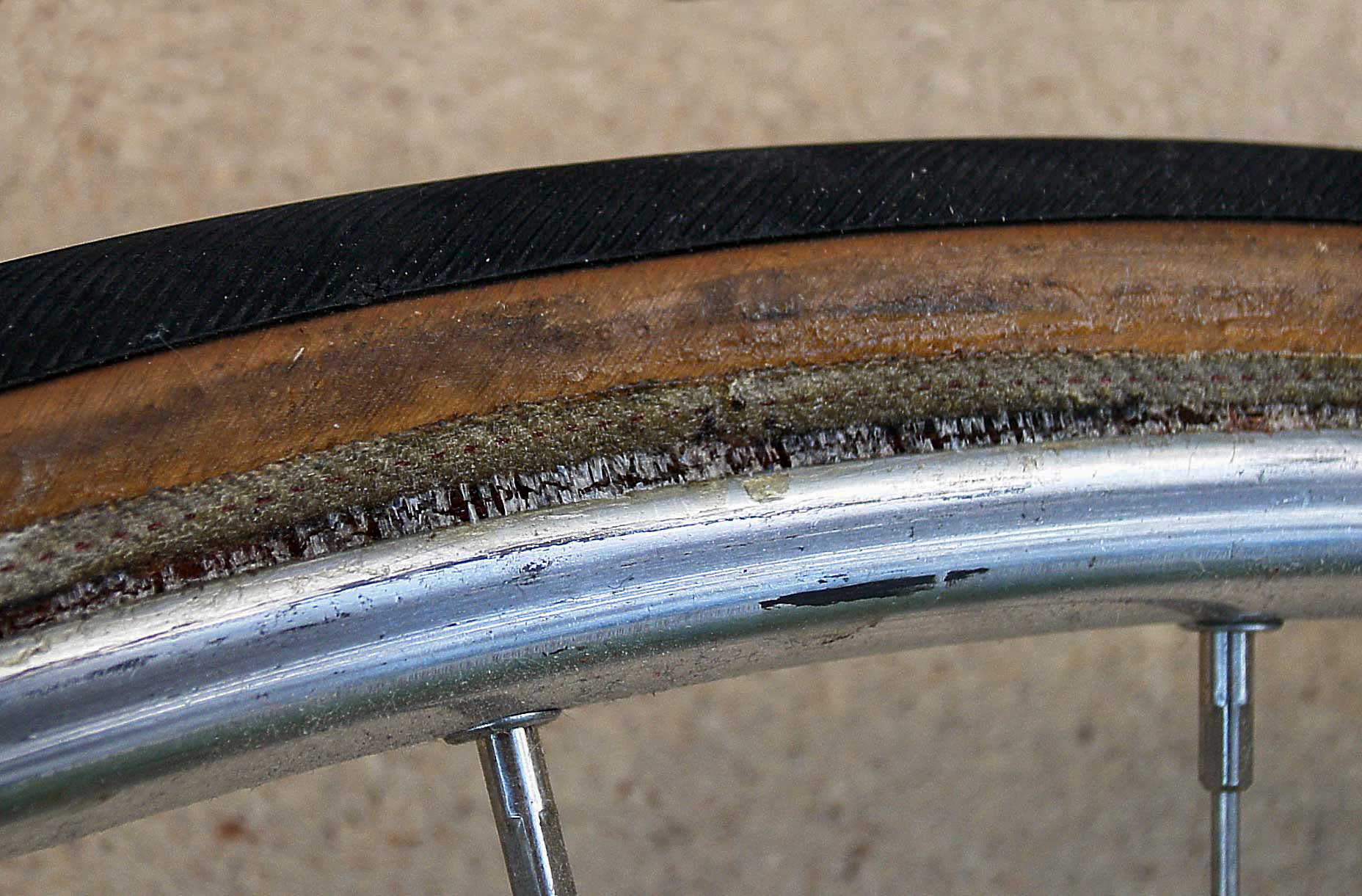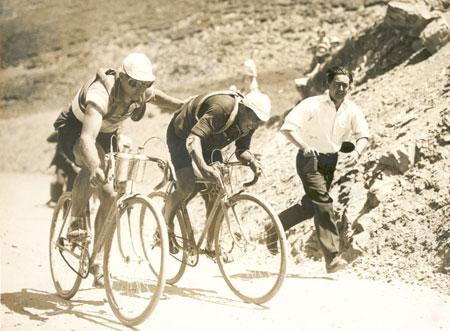|
Tubular Tire
A tubular tyre, referred to as a tub in Britain, a sew-up in the US, a single in Australia, or just a tubular is a bicycle tyre that is stitched closed around the inner tube to form a torus. The combination is then glued (sometimes with two-sided tape) onto a specially designed rim, referred to as a "sprint rim" in Britain, and just a "tubular rim" in the US, of a bicycle wheel. Tubular tyres require more labour to repair a puncture than clincher tyres (wired–on in Britain). The tyre must be removed from the rim, opened up, patched, sewn back up, then finally glued back to the rim. Clinchers have largely replaced tubulars for amateur racing (although they have seen a revival due to the carbon rim being better suited to tubular design), but tubulars are still commonly used for indoor track racing (where the closed track makes punctures from road debris less commonplace), professional road racing, road time trials, and cyclo-cross racing. The resulting combination was either sl ... [...More Info...] [...Related Items...] OR: [Wikipedia] [Google] [Baidu] |
Bicycle Tire
A bicycle tire is a tire that fits on the wheel of a bicycle or similar vehicle. These tires may also be used on tricycles, wheelchairs, and handcycles, frequently for racing. Bicycle tires provide an important source of suspension, generate the lateral forces necessary for balancing and turning, and generate the longitudinal forces necessary for propulsion and braking. Although the use of a pneumatic tire greatly reduces rolling resistance compared to the use of a rigid wheel or solid tire, the tires are still typically, the second largest source, after wind resistance (air drag), of power consumption on a level road. The modern detachable pneumatic bicycle tire contributed to the popularity and eventual dominance of the safety bicycle. Bicycle tires are also used on unicycles, tricycles, quadracycles, tandem bicycles, hand cycles, bicycle trailers, and trailer bikes. History The first bicycle "tires" were iron bands on the wooden wheels of velocipedes. These were fo ... [...More Info...] [...Related Items...] OR: [Wikipedia] [Google] [Baidu] |
Inner Tube
An inner tube is an inflatable ring that forms the interior of some pneumatic tires. The tube is inflated with a valve stem, and fits inside of the casing of the tire. The inflated inner tube provides structural support and suspension, while the outer tire provides grip and protects the more fragile tube. They are widely used in bicycles and are also used in many motorcycles and heavy road vehicles such as trucks and buses. They are now less common in other wheeled vehicles because of the benefits of having no tube, such as the ability to operate at low pressure and at high pressure (unlike a tube tire, which would pinch at low pressure and burst at high pressure), without going flat. Large inner rings also make effective flotation devices and are widely used in the leisure activity of tubing. Material The tube is made out of a mix of natural and synthetic rubber. Natural rubber is less prone to punctures and is often more pliable, while synthetic rubber is cheaper. Often racin ... [...More Info...] [...Related Items...] OR: [Wikipedia] [Google] [Baidu] |
Torus
In geometry, a torus (plural tori, colloquially donut or doughnut) is a surface of revolution generated by revolving a circle in three-dimensional space about an axis that is coplanar with the circle. If the axis of revolution does not touch the circle, the surface has a ring shape and is called a torus of revolution. If the axis of revolution is tangent to the circle, the surface is a horn torus. If the axis of revolution passes twice through the circle, the surface is a spindle torus. If the axis of revolution passes through the center of the circle, the surface is a degenerate torus, a double-covered sphere. If the revolved curve is not a circle, the surface is called a ''toroid'', as in a square toroid. Real-world objects that approximate a torus of revolution include swim rings, inner tubes and ringette rings. Eyeglass lenses that combine spherical and cylindrical correction are toric lenses. A torus should not be confused with a '' solid torus'', which is formed by r ... [...More Info...] [...Related Items...] OR: [Wikipedia] [Google] [Baidu] |
Bicycle Wheel
A bicycle wheel is a wheel, most commonly a wire wheel, designed for a bicycle. A pair is often called a wheelset, especially in the context of ready built "off the shelf" performance-oriented wheels. Bicycle wheels are typically designed to fit into the bicycle frame, frame and bicycle fork, fork via Dropout (bicycle part), dropouts, and hold bicycle tires. Invention The first wheel to use the tension in wire wheel, metal spokes was invented by George Cayley, Sir George Cayley to achieve lightness in his 1853 glider. Construction The first bicycle wheels followed the traditions of carriage building: a wooden hub, a fixed steel axle (the bearings were located in the fork ends), wooden spokes and a shrink fitted iron tire. A typical modern wheel has a metal hub, wire tension spokes and a metal or carbon fiber rim which holds a pneumatic rubber tire. Hub A hub is the center part of a bicycle wheel. It consists of an axle, bearing (mechanical), bearings and a hub shell. Th ... [...More Info...] [...Related Items...] OR: [Wikipedia] [Google] [Baidu] |
Road Debris
Road debris, a form of road hazard, is debris on or off a road. Road debris includes substances, materials, and objects that are foreign to the normal roadway environment. Debris may be produced by vehicular or non-vehicular sources, but in all cases it is considered litter, a form of solid waste., AAA Foundation for Traffic Safety press release o"The Safety Impact of Vehicle-Related Road Debris" Gerry Forbes and John Robinson, June 2004 Debris may tend to collect in areas where vehicles do not drive, such as on the edges (shoulder), around traffic islands, and junctions. Road spray or tire kickup is road debris (usually liquid water) that has been kicked up, pushed out, or sprayed out from a tire. In 2004, a AAA Foundation for Traffic Safety study revealed that vehicle-related road debris caused 25,000 accidents and nearly 100 deaths a year. Causes Road debris can be caused by various factors, including objects falling off vehicles or natural disasters and weather, specifical ... [...More Info...] [...Related Items...] OR: [Wikipedia] [Google] [Baidu] |
Road Bicycle Racing
Road bicycle racing is the cycle sport discipline of road cycling, held primarily on Road surface, paved roads. Road racing is the most popular professional sport, professional form of bicycle racing, in terms of numbers of competitors, events and spectators. The two most common competition formats are mass start events, where riders start simultaneously (though sometimes with a Handicapping, handicap) and race to a set finish point; and time trials, where individual time trial, individual riders or team time trial, teams race a course alone against the clock. Stage races or "tours" take multiple days, and consist of several mass-start or time-trial stages ridden consecutively. Professional racing originated in Western Europe, centred in France, Spain, Italy and the Low Countries. Since the mid-1980s, the sport has diversified, with races held at the professional, semi-professional and amateur levels, worldwide. The sport is governed by the Union Cycliste Internationale (UCI). As w ... [...More Info...] [...Related Items...] OR: [Wikipedia] [Google] [Baidu] |
Presta Valve
The Presta valve (also French valve (FV) or Sclaverand valve) is a tire valve commonly found in high pressure road style and some mountain bicycle inner tubes. It comprises an outer valve stem and an inner valve body. A lock nut to secure the stem at the wheel rim and a valve cap may also be present. Name The '' Sclaverand valve'' was invented by Frenchman Etienne Sclaverand and is often referred to as the ''French valve''. Today it is also known as ''Presta valve''. ''Presta'' or ''presto'' stands in the Romance languages for "fast, hurry, immediately". Description The outer valve stem is manufactured in various lengths for different applications and has a narrower diameter () than Dunlop and Schrader valves (). The weakest point of a bicycle rim is usually the hole for the valve stem. The smaller hole for a Presta valve makes it possible to have extremely narrow wheels while maintaining sufficient strength in the wheel. The air pressure in an inflated tire holds th ... [...More Info...] [...Related Items...] OR: [Wikipedia] [Google] [Baidu] |
Great Britain
Great Britain is an island in the North Atlantic Ocean off the northwest coast of continental Europe. With an area of , it is the largest of the British Isles, the largest European island and the ninth-largest island in the world. It is dominated by a maritime climate with narrow temperature differences between seasons. The 60% smaller island of Ireland is to the west—these islands, along with over 1,000 smaller surrounding islands and named substantial rocks, form the British Isles archipelago. Connected to mainland Europe until 9,000 years ago by a landbridge now known as Doggerland, Great Britain has been inhabited by modern humans for around 30,000 years. In 2011, it had a population of about , making it the world's third-most-populous island after Java in Indonesia and Honshu in Japan. The term "Great Britain" is often used to refer to England, Scotland and Wales, including their component adjoining islands. Great Britain and Northern Ireland now constitute the ... [...More Info...] [...Related Items...] OR: [Wikipedia] [Google] [Baidu] |
André Leducq
André Leducq (; 27 February 1904 – 18 June 1980) was a French cyclist who won the 1930 and 1932 Tours de France. He also won a gold medal at the 1924 Summer Olympics in the team road race event and the 1928 Paris–Roubaix. Career Leducq was born at Saint-Ouen. He was world champion in 1924 as an amateur before turning professional in 1927. The following year he won Paris–Roubaix and was second in the Tour de France, becoming popular for his humour. His other victories included two Tours de France (he won 25 stages in nine rides) and the 1931 Paris–Tours. He has the fourth-highest number of stage wins in the Tour de France (behind Eddy Merckx, Bernard Hinault, and Mark Cavendish). After his retirement, he founded a professional cycling team that raced in the 1950s. Career achievements Major results ;1927 : Tour de France :: 4th overall ::Stage 6, 23 and 24 wins ;1928 :Tour de France :: 2nd overall ::Stage 2, 10, 11 and 16 wins :Paris–Roubaix ;1929 :Tour de Fran ... [...More Info...] [...Related Items...] OR: [Wikipedia] [Google] [Baidu] |








